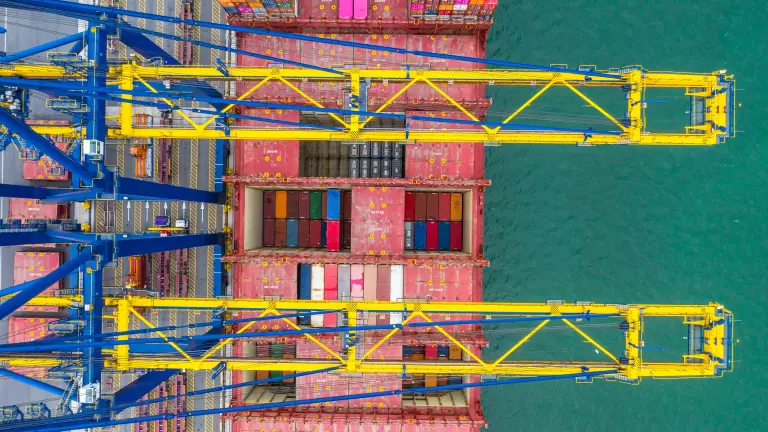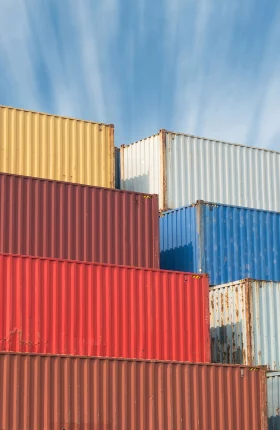The global trade landscape has been roiled by geopolitical tensions, the pandemic, rising protectionism, and tightening restrictions on technology products. But one region is in better position than any other to emerge a big winner from all the disruption. The ten-nation Association of Southeast Asian Nations (ASEAN) not only remains one of the world’s biggest and most dynamic growth zones. It has also avoided trade conflicts and even expanded free-trade pacts with its major partners.
The proof is already visible in trade data. From 2017 through 2021, at a time when global trade grew by 24% annually, ASEAN trade grew by 33%. The trend was even more pronounced in certain trade routes. China’s trade with the US, for which more current data is available, expanded by a modest 6% from 2017 through 2022. But ASEAN’s trade with the US surged by 98% over that period, while bilateral trade between ASEAN and China grew by 95%.
By 2031, ASEAN exports will surge by nearly 90%. Meanwhile, overall global trade will grow by less than 30%.
This pattern can be expected to continue in the decade ahead. As supply chain management strategy shifts from “just in time” to “just in case,” more companies from East Asia, the US, and Europe are readjusting their global sourcing and manufacturing footprints for everything from consumer electronics and fashion apparel to auto parts and machinery. As a result, we forecast that by 2031, ASEAN exports will surge by nearly 90%, to around $3.2 trillion annually. Meanwhile, overall global trade will grow by less than 30%.
This tectonic shift presents an enormous opportunity. By deftly leveraging ASEAN’s growing strategic importance as both a market and an export manufacturing platform, the region’s companies can leap into higher-value businesses in a wide range of industries.
They can seek to capture greater shares of the global value chains in their own industries. They can use advanced digital technologies to transform their businesses. And they can improve their global competitiveness by achieving the highest environmental, social, and governance (ESG) standards.
ASEAN’s Strategic Advantages
ASEAN is well positioned to capitalize on the rebound in global trade. Well before the onset of the COVID-19 pandemic and Russia’s invasion of Ukraine, global businesses had begun moving more manufacturing and sourcing to Southeast Asia. One reason is that China’s once overwhelming cost advantage in labor-intensive industries began to wane around a decade ago as the nation rapidly developed. While manufacturing in China remains significantly cheaper than in the EU, US, and Japan in many industries, direct manufacturing costs in Indonesia, Thailand, and Malaysia are 10% to 15% lower than in China, according to BCG’s Global Manufacturing Cost Competitiveness Index .
This makes Southeast Asia an attractive location for Western and East Asian multinationals—including those based in China—that need an additional low-cost export manufacturing platform in the Asia-Pacific region. The production shift to ASEAN has accelerated in the past few years due to trade tensions between China and several major trading partners and factory lockdowns during the pandemic, which highlighted the urgency of making supply chains more resilient to disruption .
ASEAN’s huge market, with a combined population of 685 million and nominal GDP of $3.6 trillion, is another powerful attraction. More than two-thirds of the region’s population is working age, and the number of middle-income and affluent households is projected to grow by around 5% annually for the rest of the decade. ASEAN’s combined GDP is projected to grow by nearly 4.6% annually over that period. Viewed as a single economy, the trade bloc will be the world’s fourth largest by 2030.
ASEAN’s economic diversity is a further strategic advantage. The region is a major producer in sectors as varied as agriculture, mining, consumer goods, heavy industries, technology services, and semiconductors. In terms of 2021 global exports, ASEAN accounted for 17% of consumer electronics, 12% of apparel, and 9% of automotive products.
Trade pacts will give ASEAN value chains preferential access to markets representing 40% of global GDP.
Finally, Southeast Asian nations are well connected both with each other and major markets around the world. ASEAN’s six original members, Brunei, Indonesia, Malaysia, the Philippines, Thailand, and Singapore, first agreed to form a regional trade bloc in 1992. The bloc then expanded to include Vietnam, Cambodia, Myanmar, and Laos. This has created opportunities for companies to build integrated supply chains and tap markets across the region.
ASEAN is a member of the Regional Comprehensive Economic Partnership (RCEP), which as of February 2023 was the world’s largest free trade area by GDP coverage. This grouping also includes Australia, China, Japan, New Zealand, and South Korea. As terms are phased in over the coming years, the RCEP will give ASEAN companies duty-free access to a combined market of 2.2 billion people for goods representing 92% of tariff lines. The RCEP also aims to harmonize nontariff measures, align standards, improve investment rules, and facilitate the cross-border exchange of data and paperless trade.
In addition, Brunei, Malaysia, Singapore, and Vietnam belong to the Comprehensive and Progressive Agreement for Trans-Pacific Partnership (CPTPP), a free-trade agreement that incorporates Australia, Canada, Chile, Mexico, New Zealand, and Peru. Taken together, these trade pacts will give ASEAN value chains preferential access to markets representing 40% of global GDP.
Capitalizing on ASEAN’s Bullish Trade Outlook
These advantages should translate into strong growth for ASEAN trade, especially when compared to the rest of the world. BCG forecasts that ASEAN trade will average 3.5% to 5% growth to 2031, where global expansion in trade is projected to grow at only 2.5% a year over the same period. While BCG projects that bilateral trade between the US and China will shrink by $63 billion over the next decade, we forecast 5.6% CAGR in ASEAN’s trade with the US, an increase of $236 billion. The region’s combined trade with the EU is projected to soar by 69% by 2031.
If ASEAN can take full advantage of these trends to move up the manufacturing value chain , BCG estimates that the region could generate up to $3 trillion in additional manufacturing output, increase annual foreign direct investment by up to $115 billion, and create 730,000 new jobs. We believe that the impact could be even greater if the region’s companies take additional measures to enhance their global competitiveness. Among the big moves ASEAN companies should consider:
Integrate supply chains within ASEAN. The increased focus on ASEAN as a trading partner provides the region a golden opportunity to attract a greater portion of global supply chains of major industries. By integrating supply chains within the region, ASEAN can be a larger producer of finished goods and a supplier of key components to the rest of the world. “Further ‘Aseanification’ of supply is something that we at Unilever really want to drive,” explains Andrew Varona, who heads Unilever’s supply chain operations in Singapore and Malaysia. “We want to go further upstream in the supply chain and further localize or regionalize our supply of key materials, as well as manufacturing and logistics solutions.”
Five industrial sectors stand out in terms of localization opportunities: automotive products, apparel, consumer electronics, agriculture, and packaged foods. ASEAN manufacturers in each sector rely significantly on imports of components and materials, many of which could be produced locally. For example, ASEAN is both one the world’s fastest-growing automotive markets and an exporter of $80 billion worth of vehicles and components a year. Yet it remains a net importer of critical, high-value inputs, particularly from China, Japan, and the EU, for vehicles assembled within the region. ASEAN is in a good position to localize much of that value chain. Chinese OEMs, for example, are expanding their assembly presence in the region and could look to produce more components closer to their factories as costs rise at home—or use ASEAN as a platform to export vehicles to other markets.
Five sectors stand out in terms of localization opportunities: automotive products, apparel, consumer electronics, agriculture, and packaged foods.
There are also opportunities for Southeast Asian auto parts makers to join forces with manufacturers in neighboring countries to expand their scale. Malaysia, Indonesia, and Thailand, for example, all have major automotive suppliers with complementary strengths and capabilities. By consolidating, they could compete for major programs of global OEMs. This is especially true if ASEAN producers can seize a first-mover advantage in next-generation automotive products, such as components for electric vehicles. For example, both Indonesia and the Philippines can leverage their large reserves of nickel—a critical material in lithium-ion batteries—to become significant players in battery-cell and component manufacturing.
ASEAN has a similar opportunity in consumer electronics. The region exports around $230 billion in consumer electronics annually. Foxconn, Ricoh, Quanta Computer, HP, Dell, and Fitbit are among the global companies that have moved some production to Vietnam and other locations in Southeast Asia to diversify their supply chains or tap new sources of educated but lower-cost labor. The region’s factories still rely heavily on mainland China, Taiwan, South Korea, and Japan for most materials and components; the next step for ASEAN is to build local supply bases for materials, key components, engineering, and other parts of the consumer-electronics value chain. Developing such a supply base, however, will require time and training.
Likewise, ASEAN exports around $110 billion worth of apparel—yet it imports most of the fabrics from neighboring countries. ASEAN already exports $65 billion worth of packaged foods a year and boasts a number of well-known brands, but with its strength in agriculture, the region can go much further. Meanwhile, ASEAN construction companies have barely begun to tap their potential as overseas contractors. And the region has the potential to become a much bigger base for data centers and other IT services, which currently account for only 1% of the region’s exports.
Leverage technology to stay ahead. The rapid adoption of the internet, smartphones, and social media is integrating Southeast Asian consumers and businesses, linking vast island archipelagos and populations separated by a wide variety of languages and cultures. ASEAN’s internet and e-commerce economy is projected to reach $1 trillion by 2030, and the region’s governments are establishing a functioning ASEAN Single Window in which certificates of origin will be filed electronically. Despite the development of digital natives in ASEAN that have created e-commerce marketplaces and fintechs, the region’s traditional companies by and large have lagged much of the rest of the world in using advanced digital technologies to transform their businesses.
But change is around the corner, with small companies transforming their businesses through digitization. At the recent symposium titled the UOB Gateway to ASEAN Conference, hosted by United Overseas Bank in Singapore, Wipavee Watcharakorn, CEO of Thailand’s Vachamon Food and Fresh Living, explained how her company developed from a small seed retailer a few decades ago into a $90 million company by establishing a regional e-commerce platform. In addition to importing from China, Vachamon connects retailers with wholesalers. It also helps Thai businesses export their produce to overseas buyers seeking fresh goods and a wide variety of choice through a one-stop shopping experience. Vachamon’s investment in technology has enabled it to become a leading player in Thailand’s food industry.
Even well-established manufacturers can transform their businesses through digitization. Some of some of the world’s oldest industrial goods companies, for example, have created new business models and profit pools by selling valued-added services based on their physical products. Rolls Royce has equipped its aircraft engines with connectivity and numerous sensors that enable customers to pay only for the time they use the equipment and that allow for remote monitoring of performance and wear and tear of its global engine fleet. Likewise, John Deere offers farmers using its connected agricultural equipment services that keep them up to date on weather patterns and help them better manage planting and fertilization. Southeast Asian manufacturers could consider similar digital-service offerings.
Differentiate through sustainability. Achieving and maintaining high ESG standards will become increasingly crucial for ASEAN companies. Businesses around the world are under growing pressure from customers, investors, employees, and regulators—both home and abroad—to reduce their carbon emissions. In late 2023, for example, the EU will start requiring importers to report the entire greenhouse-gas footprints for certain goods and materials they bring into the world’s second-largest market. In a few years, the EU will start assessing a progressively higher tax on each metric ton of emissions associated with those imports. We estimate that carbon border taxes will affect at least 20% of ASEAN exports to the EU, including steel, cement, aluminum, and fertilizer. And the list is expected to expand in the future. The EU, as well as the US, Canada, and Australia, are also imposing tougher prohibitions on importing goods tied to child or forced labor.
Some ASEAN companies are fully embracing the sustainability imperative and viewing as a source of competitive advantage.
Some ASEAN companies are fully embracing the sustainability imperative and viewing as a source of competitive advantage. Thai construction materials giant Siam Cement, for example, has developed low-emission goods and services that it believes can generate $1 billion in revenue during the next decade, including ecofriendly cement and polymers.
BCG research has also found that companies that close the “sustainability gap” with competitors can enjoy higher customer satisfaction and better access to investment capital, talent, and overseas markets. Lim Chern Yuan, group CEO of Yinson Holdings, explains that it is important to embed a long-term sustainability strategy into your business model. “We regularly engage with our stakeholders—employees, banking partners, investors, and suppliers—on matters that are material to them,” he says. “We have found that incorporating sustainability into our strategy allows us to gain better access to projects that align with our sustainability goals and positions us to take advantage of better pricing offered through sustainability-linked financing instruments.”
Musim Mas, Indonesia’s biggest exporter of palm oil, illustrates how ASEAN companies can use sustainability as a competitive advantage. Palm oil production on large monocultural plantations has been under growing scrutiny due to concerns over the potential ecological and social side effects of land use. When the EU issued new regulations on imported biofuels, Musim Mas was in a strong position because all of its mills have facilities for capturing methane, which reduces emissions. Musim Mas has also started procuring more of palm from smallholders, who account for 40% of its supply base, and working with local governments to help them develop sustainable practices for the longer term. This not only improved the resilience of Musim Mas’s supply chain and enhanced the livelihoods of small farmers, but also gave the company a competitive edge against slower-moving rivals by becoming compliant with EU standards.
Subscribe to receive BCG insights on the most pressing issues facing international business.
Even small and midsized enterprises can incorporate sustainability into commercially viable goods and services. Singapore’s Samwoh Group, a construction company that provides a suite of engineering services, improved its competitiveness by investing in R&D to create low-carbon versions of construction materials, such as by recycling plastic into asphalt that is used to pave sections of public roads. Samwoh also has found innovative ways to incorporate materials recycled from construction and demolition waste. The company’s headquarters, Samwoh Smart Hub, uses solar panels extensively and is built entirely of recycled aggregates, making it the first net energy positive building in Singapore.
Favorable trade winds are now blowing strongly in ASEAN’s direction. The region’s business leaders should not less this opportunity pass. By leveraging competitive costs, industrial breadth, an immense domestic market, and enviable connections to the world’s biggest markets, ASEAN can create new growth opportunities, broaden economic development, and assume a greater presence on the world stage.
This content was developed in collaboration with UOB.


















